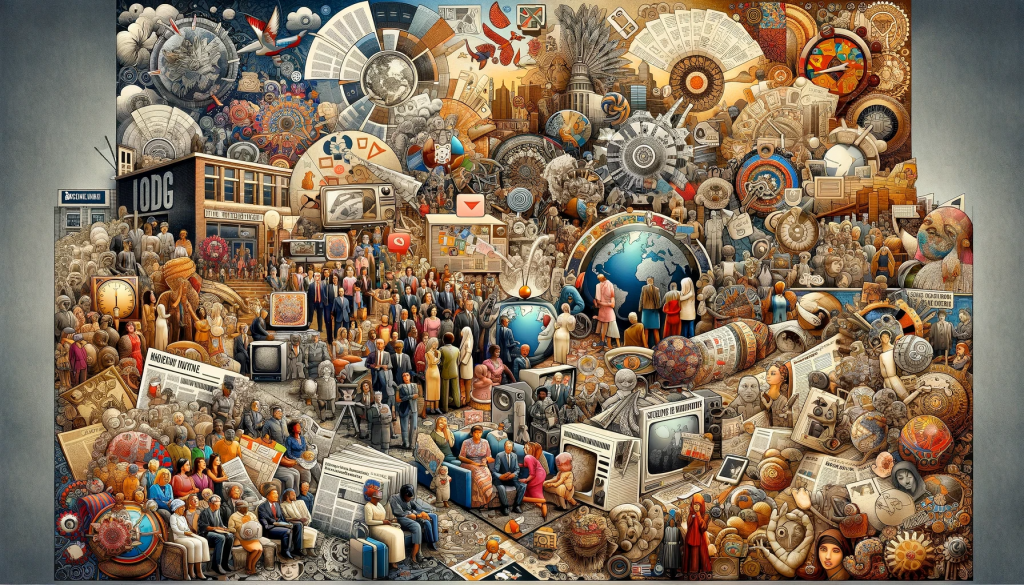Mass Communication Characteristics – 14+ Examples
Mass communication, a crucial aspect of modern society, plays a pivotal role in disseminating information to large audiences. This comprehensive guide delves into the distinct characteristics of mass communication, enriched with practical examples. We’ll explore how various communication examples illustrate the power and reach of mass media. From broadcasting news to social media trends, our guide offers insights into the mechanisms that make mass communication an influential force in shaping public opinion and cultural dynamics. Stay tuned for an enlightening journey through the world of mass communication.
What are Mass Communication Characteristics? – Definition
Mass communication refers to the process of conveying messages, information, and ideas to a large and diverse audience through various forms of media. This includes television, radio, newspapers, the internet, and social media. The defining characteristics of mass communication involve its ability to reach a wide audience simultaneously, often across vast geographical areas. It’s distinguished by its one-to-many communication model, where a single source transmits information to a multitude of receivers. Mass communication is typically a one-way process, where feedback from the audience is indirect and delayed. It plays a crucial role in shaping public opinion, disseminating news, and influencing social and cultural norms. The nature of mass communication is constantly evolving with technological advancements, making it an integral part of modern society.
15 Mass Communication Characteristics
Mass communication, with its far-reaching influence, encompasses a variety of characteristics that define its role and impact in society. Here, we present 15 key characteristics of mass communication, each accompanied by a unique example and explanation, illustrating its practical applications and significance

Wide Reach
Wide reach is a fundamental characteristic of mass communication, allowing messages to connect with a vast and diverse audience rapidly. This extensive coverage is crucial in broadcasting, social media, and journalism, making it a powerful tool in shaping public opinion and disseminating information. A prime example of wide reach in mass communication is the use of television broadcasting during significant events like the Olympics. These broadcasts bring together millions of viewers worldwide, showcasing the incredible ability of mass media to bridge geographical and cultural divides. By utilizing platforms like television and social media, mass communication achieves a global impact, making it an essential aspect of contemporary society and a cornerstone in the field of journalism and broadcasting.
Example: National television broadcasts like the Super Bowl. Television broadcasting reaches millions, making events like the Super Bowl a shared experience across different demographics.

Rapid Dissemination
In mass communication, rapid dissemination is the swift and widespread distribution of information to a large audience. This characteristic is crucial in the digital age, where news and updates are expected instantly. Through platforms like social media and email, information reaches people globally in seconds, making it a cornerstone in broadcasting and journalism. Rapid dissemination highlights the ability of mass communication to keep the public informed and connected, especially in critical scenarios.
Example: Breaking news alerts on social media. Social media platforms ensure immediate delivery of important news, keeping the public informed in real time.

Public Accessibility
One of the core characteristics of mass communication is its public accessibility. From broadcasting mass communication to digital platforms like blogs and emails, the aim is to provide information that is easily accessible to everyone. This accessibility is a cornerstone in ensuring that mass communication serves its purpose of disseminating information widely, reflecting the uses and benefits of mass communication in everyday life and in specialized fields like education and public awareness.
Example: Free-to-air TV channels. These channels provide news and entertainment, making information accessible without cost barriers.

Influential
The influential nature of mass communication is undeniable, particularly in shaping public opinion and societal norms. Whether it’s through journalism mass communication or advertising campaigns, the impact on audience attitudes and behaviors is significant. This power underscores the main functions of mass communication, highlighting its role in not only informing but also persuading and influencing the masses, making it a pivotal tool in both public relations and broadcasting.
Example: Advertising campaigns. Campaigns, especially those on mass media, shape consumer preferences and social trends.

Heterogeneous Audience
Mass communication uniquely caters to a diverse, heterogeneous audience, encompassing various demographics, interests, and backgrounds. This characteristic is vital in mass communication scenarios, where content must appeal to a broad spectrum of individuals. From social media mass communication to television broadcasting, the ability to engage a varied audience is crucial, demonstrating why mass communication is important in reaching and resonating with a global population.
Example: Online news portals. These portals offer a range of topics, appealing to different interests and demographics.

Feedback Loop
The feedback loop in mass communication refers to the interaction between the communicator and the audience. Although indirect and delayed, feedback is a crucial component, particularly in television and radio broadcasting. It allows media professionals to gauge audience reactions and adjust their content accordingly. This characteristic is integral to understanding the impact of mass communication in real life, shaping future communication strategies and content.
Example: TV show ratings and reviews. Viewer feedback through ratings and online reviews shapes future content.

Professional Communication
Professional communication is a key aspect of mass communication, encompassing the skilled creation and delivery of messages. This characteristic is vital in journalism and broadcasting, where accuracy and clarity are paramount. It involves the strategic use of language and media tools to effectively convey information, often seen in public relations and advertising. Professional communication ensures that messages are not only received but also understood and acted upon as intended.
Example: Journalism in broadcasting. Broadcast journalism demonstrates skilled reporting and content delivery.

Standardized Messages
Standardization is a significant characteristic of mass communication, especially evident in television mass communication and public relations mass communication. Standardized messages ensure a consistent and clear delivery of information to a broad audience. This uniformity is key in maintaining the integrity and clarity of the information disseminated, regardless of the medium used.
Example: National weather forecasts. Weather forecasts provide standardized information essential for a wide audience.

Technology-Dependent
Mass communication heavily relies on technology, particularly in forms like social media mass communication and email mass communication. This dependence on technology ensures the rapid dissemination and wide reach of messages. The evolving landscape of digital technology shapes how information is transmitted and received, making mass communication an ever-changing field driven by technological advancements.
Example: Email newsletters. Emails use digital technology to disseminate information efficiently.

Dynamic Content
A key characteristic of mass communication is its dynamic content, constantly adapting to current events and audience preferences. This aspect is crucial in broadcasting mass communication and journalism mass communication, where news and information need to be updated regularly to reflect the latest developments. Dynamic content keeps mass communication relevant and engaging, ensuring that audiences are informed with the most current information.
Example: 24-hour news channels. These channels update content continuously, reflecting the dynamic nature of news.

Cultural Representation
Mass communication plays a pivotal role in reflecting and shaping cultural norms and values. Cultural representation in mass communication, evident in television mass communication and public relations mass communication, highlights diverse societal beliefs and practices. It not only mirrors the existing cultural landscape but also influences societal perceptions and behaviors. The portrayal of various cultures in mass communication can foster understanding and acceptance, making it a powerful tool for cultural exchange and enlightenment.
Example: Television sitcoms. Sitcoms often mirror and subtly influence cultural and societal norms.

Regulated
Regulation is a fundamental characteristic of mass communication, ensuring that content meets ethical, legal, and professional standards. This is particularly significant in broadcasting mass communication and journalism mass communication, where adherence to regulations maintains the integrity and trustworthiness of the information disseminated. Regulation shapes the mass communication scenario, guiding how information is presented and consumed. It’s essential for maintaining the balance between freedom of speech and responsible communication.
Example: Broadcasting standards for TV. Regulations ensure content adheres to accepted ethical and legal standards.

Interactive
Modern mass communication thrives on interactivity, a characteristic crucial in today’s digital age. Interactive mass communication, especially prevalent in social media mass communication and online journalism, fosters a two-way dialogue between the media and its audience. This engagement not only enriches the communication process but also enhances the relevance and impact of the content. It reflects the shift from traditional, one-way communication to a more dynamic, participative form, as seen in various mass communication examples in real life.
Example: Social media platforms. Platforms like Twitter allow direct interaction between broadcasters and the audience.

Convergence
Convergence is a key characteristic of modern mass communication, reflecting the blending of various media forms. This integration is evident in how news is presented across platforms, combining text, video, and interactive elements for a comprehensive experience. Convergence enhances the accessibility and impact of mass communication, as seen in journalism and broadcasting, where diverse content forms come together to create more engaging and informative narratives. This convergence is crucial for effective communication in our increasingly digital and interconnected world.
Example: News apps with video, text, and infographics. These apps demonstrate the convergence of various forms of media.

Persuasive Nature
One of the fundamental characteristics of mass communication is its persuasive nature. This aspect is pivotal in areas like advertising and political campaigns, where the goal is to influence public opinion or consumer behavior. The persuasive nature of mass communication utilizes strategic messaging to sway audiences, exemplified in social media campaigns and television advertisements. It plays a critical role in shaping societal norms and views, highlighting why understanding mass communication is essential in today’s digital age.
Example
Political campaigns on mass media. These campaigns are designed to influence public opinion and voting behavior

Understanding the characteristics of mass communication is essential in today’s interconnected world. This guide has provided valuable insights into how to effectively harness these traits, from the persuasive nature of media to the convergence of different platforms. Armed with these tips, you’re now better equipped to navigate the dynamic landscape of mass communication.



